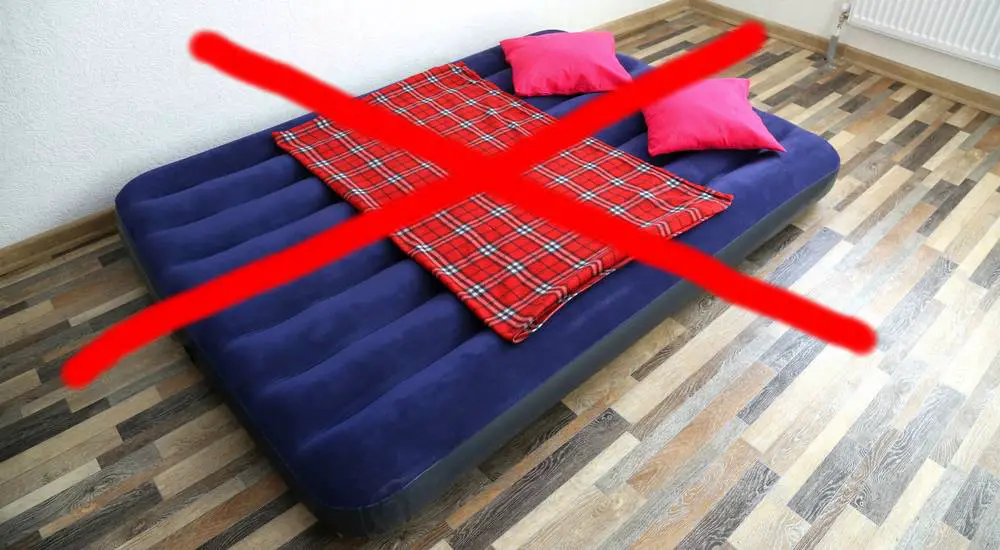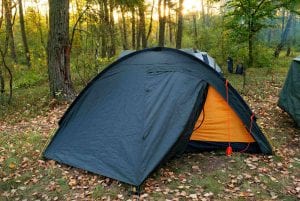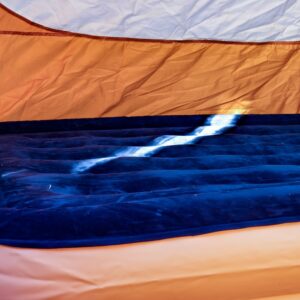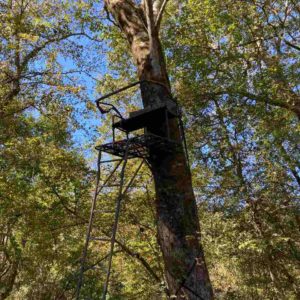
Let’s cut to the chase. Air mattresses suck.
They’re cold to sleep on. They squeak. They bounce you around. They deflate quickly. They’re susceptible to punctures.
Let’s end the madness!
The good news is there are options. So whether you’re camping out in the woods or just crashing at a friend’s place for a sleepover, there are plenty of air mattress alternatives that’ll give you a good night’s sleep.
TL;DR – Best Air Mattress Alternatives
People dislike air mattresses because they can be cold, leaky, and easily punctured.
The best air mattress alternative for most situations is probably an insulated air mattress like the Exped Megamat or the Sea to Summit Comfort Deluxe. See a list of recommended insulated air mattresses here >>
For sleepovers where you’re bedding down indoors and bulk isn’t an issue, some of the best air mattress alternatives include futons and rollaway beds.
Even if you’re camping out, there are plenty of ways to sleep that don’t involve an air mattress. Car campers could use a camping cot or truck bed mattress, while hikers often favor self-inflating mats or closed-cell foam pads.
Why Ditch the Air Mattress?
When you’re getting gear together for your next camping trip or even just preparing for a sleepover, grabbing the air mattress is the default option. But it’s not always the best one.
Sure, inflatable sleeping pads are lightweight and comfortable — and the budget models can be real cheap — but those things aren’t always at the top of your priority list. Because who really cares about featherlight weight if all you’re doing is dragging it out of the garage and setting it up in the living room?
An air mattress also has its downsides. Ultimately, every camping gear choice is about compromise. Here are a few of the less impressive things about inflatables…
They Can Feel Cold
Everyone’s had that miserable night on an air bed at some point in their life. It looks so squishy and comfy when you lie down for the night, but even in a heated house you find yourself getting chilly from underneath — let alone if you’re sleeping out in a tent in colder weather.
Even a good sleeping bag isn’t always enough to keep the chills at bay.
The problem is that a cheaper air mattress won’t have any insulation, so there’s basically just a paper-thin layer of plastic between your sleeping bag and the cushion of cold air you’re lying on.
You can get around the problem by upgrading the insulation with blankets or foam, but you might also want to consider an air mattress alternative.
Learn more about staying warm in a tent with our 13 top tips.
The Mattress Deflates in the Night
An air mattress starts out taut and springy like a cartoon cloud, but as you close your eyes and drift off to sleep, the anxiety dreams begin. You’re lying on your back in a pool of quicksand, sinking slowly through Jell-O… Then you wake up at 4am to find that your ass is on the tent floor and the half-deflated mattress is bulging around you like a stricken life raft.
Unfortunately, some air mattresses are forever leaking air in the night, even if they’re brand new and haven’t been punctured. The seals on budget models just aren’t that good.
They’re Easy to Puncture
This is a big one for hikers. There’s no point in taking lightweight kit on a trip if it’s not tough enough for the trail, and unfortunately tents — and the outdoors in general — are full of things that can poke a hole in an air mattress.
You might be able to fix smaller leaks if you’ve remembered your puncture repair kit, but it’s not ideal, and half deflated beds are no use to anyone.
They’re Hard Work to Pump up
With more modern indoor air mattresses you can often just plug them in, flip a switch, and let the electric motor do the legwork. However, with cheaper or older models you’ll probably still have to spend ten minutes hammering away at a foot pump.
This effort can feel even more like hard work in the great outdoors, when you get to the end of a long day on the trail and suddenly have to summon up enough breath and energy to blow up an airbed.
It’s times like this that a hand-held battery pump or one of those clever inflater bags can more than justify their pack weight.
A Thought: Do You Just Need a Better Air Mattress?
Often when people say they “hate air mattresses,” what they actually hate are cheap air mattresses. The thing about air pads is that there’s a huge range of them out there, from glorified lilos to expedition-grade sleeping mats that cost upwards of two hundred bucks.
While a ten-dollar air mattress will probably suffer from all the problems mentioned above, a more expensive one won’t — so you might just want to consider upgrading your air bed before you throw the baby out with the bathwater.
For more advice, check out our guide to sleeping warm on an air mattress.
Air Mattress Alternatives for Indoors
Generally, alternatives to air mattresses can be divided into indoor and outdoor options. While some options work equally well for sleepovers and camping trips, the considerations are quite different.
For indoor sleepovers, warmth is less of an issue, since the floor and air won’t be nearly as cold. Indoor air mattress alternatives can also be bulkier and more comfortable, since you won’t have to carry them long distances on your back like you do with a camping mat.
Futons
For the best indoor air mattress alternative, allow us to take you on an imaginary trip to Japan — a densely populated country where apartments are compact and people have gotten amazingly clever about making the most of limited space.
In Japan, the futon mattress is king. These comfortable, pliable mattresses can be rolled up and put in a closet when they’re not in use, meaning that the same room can be a living space during the day and a bedroom at night. People use them as guest beds and even sleep on them day-in, day-out as their regular bed.
Futons aren’t so comfy on really hard floors (in Japan they’re placed on soft tatami reed matting), but they work well on carpets or rugs. They’re warmer and more comfortable than most air mattresses, but you need a reasonable sized closet to store them in.
Note that a Western-style futon is more like a sofa bed, so we’ll chat about them below.
Folding Beds
Kind of like a futon, these are foam mattresses that you can lay on the floor as a temporary bed, only these ones are jointed so that they fold up into two or three sections. They’re often constructed from memory foam, making them a great air mattress alternative.
The foam bedding tends to be a bit stiffer than a futon, but the bed also looks a lot neater when it’s folded up, so you can use it as a footstool. They sometimes have a molded pillow on the top section that can double as a sort of low chair back when it’s folded.
Sofa Beds
A staple of apartment-dwellers the world over, a sofa bed converts to give you an extra guest bed for sleepovers, and can be a great alternative to a bulky air mattress if you’re short on storage space. Just pull it out, unroll your sleeping bag, and it’s off to Never-Never land.
A close cousin to the sofa bed is the Western-style futon. Not to be confused with the flexible Japanese floor mattress, this type of futon is a much thicker, stiffer mattress placed over a wooden frame to make a simple sofa that can be converted into a temporary bed.
Rollaway Beds
A rollaway bed, also sometimes called a camping bed, is a bed frame and mattress set-up that folds down to a smaller size for easy storage. They’re usually on wheels — making them easy to move around the house — and some of them can be every bit as comfy as an actual bed.
While most rollaway beds are still quite bulky, they have a diminutive cousin called the camping cot. These lightweight camping beds provide fantastic comfort for weight, and can even work for backpackers. We’ll talk about them below.
Murphy Beds
These were all the rage in the post-war years, and they remind us of old-school spy movies set on overnight trains. Also known as “wall beds,” they’re housed vertically in walls or cabinets when not in use. You pull them down when you want to use them, then flip them back up in the morning.
Murphy beds are a decent solution if you’ve got a study or box room where you want to fit in an occasional guest bed, but if you’re just looking for an easy air mattress alternative to facilitate sleepovers, it’s quite an expensive and over-elaborate solution.
Memory Foam Sleeping Pads
A memory foam sleeping pad is kinda like a cross between a futon and a foam camping mat. They’re too thick and bulky for a hiking trip, but the memory foam makes for a soft bed, and they’re decent enough as an alternative to an air mattress for indoor sleepovers or car camping.
For some reason, memory foam camping pads have never really taken off — perhaps because they’re not as packable as other options and they can also be quite expensive. For a similar price you can often pick up a higher-end insulated air mattress that packs down small and doesn’t have the drawbacks of cheaper models.
Old-School Foam Mattresses
Back in the day, we all had one of these monsters taking up an entire closet somewhere. Filled with open cell foam (the spongy yellow stuff you get in your car seats and couch cushions), these portable dust depots were the cause of many a childhood asthma attack when the family got together for holiday seasons.
If you’ve still got an old foam pad kicking around then they’re a decent enough air mattress alternative for sleepovers, but you probably wouldn’t buy one new. If you even can these days.
Mattress Toppers
If the contents of your wallet mostly consist of cobwebs and small change, you could always consider using a mattress topper as a cheap and cheerful foam pad. The polyester-filled ones are just about comfy enough to sleep on indoors, while the memory foam toppers are pretty similar to a memory foam camping pad — but at a much lower price point.
Alternatives to Air Mattresses for Camping
Not all campers enjoy sleeping on air mattresses, especially in cold weather when they can suffer from a lack of insulation. Fortunately, there are loads of good alternatives to air mattresses for both summer and winter camping.
On a camping trip, you’ve got a different set of considerations to an indoor sleepover. Air mattress alternatives for camping need to be warmer and more durable — and perhaps also more lightweight and packable if you’re going to be taking them on a hiking trip.
Closed-Cell Foam Mats
If you took your first camping trip as a kid, chances are you slept on one of these. Closed cell foam sleeping pads are a Boy Scout staple, and they do the job pretty well.
The dense foam sleeping pads you use for camping are a bit different from the ones you might use indoors. Chiefly, they tend to be thinner and harder. That’s because the camping ones are designed mainly for insulating you from the cold ground rather than providing padding. They’re not the comfiest, but they’ll help you retain heat well enough, and they’re pretty much the cheapest option out there.
Self-Inflating Mats
Self-inflating pads are the main air mattress alternative for camping. A self inflating mattress features a combination of foam and air chambers. In general, self inflating sleeping pads are usually warmer and more durable than air mattresses but not quite as deep or lightweight.
Self inflating sleeping pads are a good air mattress alternative for thru-hikers on long trails. They’re tough, reliable, and help you hold onto your body heat during the night — plus there’s the added bonus that you don’t have the effort of blowing them up at the end of a long day.
Hammocks
If you haven’t tried hammock camping then you’re missing out. Hammocks are super comfortable, but unless you’re sleeping somewhere very warm, they’re not really an air mattress alternative on their own.
That’s because most hammocks don’t feature any insulation underneath, so the night air all around you can make hammock camping very cold indeed. It’s no problem though — all you have to do is add some insulation before you get in, whether that’s blankets, a self inflating mattress, or a special shaped hammock pad.
Skins and Furs
A niche option, but some outdoor professionals we know swear by sleeping on thick sheepskins or reindeer pelts on a camping trip.
It makes good sense when you think about it — furs are naturally engineered for warmth and padding, and while they’re too bulky for hikers, they can certainly be a viable option for car campers or anyone staying in a fixed camp.
Skins and furs work especially well as hammock liners, and there’s something a bit special about using a natural by-product rather than resorting to the synthetic materials that make up pretty much everything else on this list.
Nothing
Using just a sleeping bag is an option that’s mainly recommended by people who’ve never been on a camping trip. The argument goes something along the lines of “there’s insulation and padding in sleeping bags, so you’ll be fine.”
Except for the fact that your bodyweight crushes that insulation and padding underneath you, rendering it largely useless.
For the avoidance of doubt, unless you are camping somewhere very warm, on a bed of springy scrub, you will get cold and the ground will feel hard without a camping mattress. We’ve all tried it and we’ve almost all regretted it.
Camping Cots
A lightweight version of the camping bed, a camping cot can be a super comfy way to sleep in the outdoors, and some camping cots are so lightweight that they can be a legitimate option for hikers. Check out our round-up of the best ones out there.
While there are ultralight, sub-3lb models out there, most camping cots fall more in the car camping bracket — light enough to carry medium distances but not to pony up a mountain (unless you literally do have a pony).
One thing to note with camping cots is that — like hammocks — there isn’t much more than a thin layer of fabric between you and the night air, so sleeping bags alone might not be quite enough to keep you warm. You’ll want to add some insulation on top, which could be as simple as a closed cell foam sleeping pad or some heavy wool blankets between you and the camping cot.
Truck Bed Mattresses
The thing is, most of these are inflatable. So does that make them air mattress alternatives or just alternative air mattresses? We couldn’t honestly say. Whatever the case, it’s a different way to sleep out.
And if you fancy ditching the foot pump, there are plenty of people on the outdoor forums recommending a DIY approach to car camping where you just buy a cheap memory foam mattress topper and cut it down to size.
This might not give you as much cushioning as an air mattress, but it’s likely to be a lot warmer, and it has the added bonus that you can make a foam sleeping pad that exactly fits your own particular vehicle.
FAQs
What Can I Use Instead of an Air Mattress?
For camping, some people choose to use a self-inflating mat, closed cell foam pad, or camping cot — while for indoor sleepovers you could try a futon or rollaway bed.
How Do You Sleep Comfortably Without an Air Mattress?
You’ll struggle to sleep comfortably without something between yourself and the ground, but there are lots of alternatives to air mattresses, from simple closed cell foam pads to hammocks and camping cots.
Are There Puncture-Proof Air Mattresses?
Higher-quality air mattresses are much more durable and less likely to get punctures, but if you’re worried about leaking air and waking up in a half deflated bed then you could try a tougher self-inflating pad.
What Should I Use if I Hate Air Mattresses?
Sometimes when you think you hate air mattresses, you actually just hate low-quality ones. Consider upgrading your existing one, or perhaps trying an alternative like a camping cot or self-inflating camping pad.





